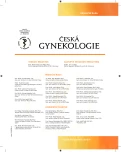-
Medical journals
- Career
Severe ovarian hyperstimulation syndrome – case study
Authors: M. Pokorná
Authors‘ workplace: Gynekologicko-porodnické oddělení Oblastní nemocnice, Kolín primář MUDr. A. Toman, MBA
Published in: Ceska Gynekol 2015; 80(6): 447-450
Overview
Objective:
To draw attention to the issue and the need of interdisciplinary cooperation in treating severe ovarian hyperstimulation syndrome (OHSS).Design:
Case study.Setting:
Department of Obstetrics and Gynecology, Hospital Kolín.Case report:
We report a case of a patient after embryotransfer that is hospitalized with a diagnosis of late severe OHSS. During the treatment when her condition is accompained by voluminous ascites, disseminated intravascular coagulation and elevated liver enzymes, it is necessary to cooperate with doctors of different specialization – anestetist, hematologist, internist.Conclusion:
Severe OHSS is a rare but serious complication of IVF treatment that due to a high number of IVF cycles is a diagnosis which every gynecologist could be confronted with. Event that numerous methods on how to prevent this condition are known these days, it is necessary not to underestimate it and to treat it thoroughly and in interdisciplinary cooperation.Keywords:
ovarian hyperstimulation syndrom, ultrasonography, ascites, pleural effusions
Sources
1. Calda, P., Břešták, M., Fischerová, D. Ultrazvuková diagnostika v těhotenství a gynekologii, 2. vyd. Praha: Aprofema, 2010,s. 411–413.
2. Cibula, D., Stárka, L., Vrbíková, J. Syndrom polycystických ovarií. Praha: Maxdorf, 2004, s. 80–85.
3. Corbett, S., Shmougun, D., Claman, P. The prevention of ovarian hyperstimulation syndrome. Obstet Gyneacol Can, 2014, 36, 11, p. 1024–1036.
4. Gautman, N., Rubina, M. Intrauterine insemination. New Dihli, India: Jaypee Brothers Medical Publishers, 2014, p. 126,
https://books.google.cz/books?id=9e28AQAAQBAJ&printsec=frontcover&hl=cs&source=gbs_ge_summary_r&cad=0#v=onepage&q&f=false
5. Hudeček, R., Huser, M., Ventruba, P. Rizikové faktory vzniku ovariálního hyperstimulačního syndromu v programu asistované reprodukce. Prakt Gyn, 2004, 4, s. 6–10.
6. Institute of Obstetricians and Gynaecologists Royal College of Physicians of Ireland, Clinical practice guideline – Ovarian hyperstimulation syndrom (OHSS) Diagnosis and management, 2012, http://www.hse.ie/eng/about/Who/clinical/natclinprog/obsandgynaeprogramme/guide8.pdf.
7. Kolařík, D., Halaška, M., Feyereisl, J. Repetitorium gynekologie, 2. rozšířené vyd. Praha: Maxdorf, 2011, s. 485–490.
8. Machač, Š., Procházka, M., Lubušký, M. Prevalence vrozených trombofilií u pacientek s těžkou formou ovariálního hyperstimulačního syndromu. Prakt Gyn, 2007, 11, 3, s. 77–80.
9. Mardešič, T. Kde je a kam směřuje asistovaná reprodukce. Actual Gyn, 2013, 5, s. 25–26.
10. Marek, D., Machač, Š. Ovariální hyperstimulační syndrom – soubor interních komplikací u gynekologických pacientek podstupující in vitro fertilizaci. Interní medicína pro praxi, 2003, 8,s. 389–393.
11. Pařízek, A. Kritické stavy v porodnictví. Praha: Galén, 2012,s. 271–273.
12. Rob, L., Martan, A., Cittebart, K. Gynekologie, 2. vyd. Praha: Galén, 2008, s. 174–178.
13. Řežábek, K. Asistovaná reprodukce. Praha: Maxdorf, 2008,s. 80–83.
14. Smith, V., Osianlis, T., Vollenhoven, B. Prevention of ovarian hyperstimulation syndrom: a review. Obstet Gynecology Inter, 2015, http://www.ncbi.nlm.nih.gov/pmc/articles/PMC4446511/.
15. Středa, R., Koryntová, D., Mardešič, T. Prokázané klinické účinky rekombinantních gonadotropinů v porovnání s urinárními v indukci ovulace, Čes Gynek, 2011, 76, 2, s. 108–113.
16. Yahia El-Faissal. Approaches to complete prevention of OHSS. Middle East Fertility Society J, 2014, 19, p. 13–15.
Labels
Paediatric gynaecology Gynaecology and obstetrics Reproduction medicine
Article was published inCzech Gynaecology

2015 Issue 6-
All articles in this issue
- Nine-valent HPV vaccine - new generation of HPV vaccine
- Spontaneous antepartal RhD alloimmunization
- Prognostic significance of Pgp, MRP1, and MRP3 in ovarian cancer patients
- Cytological-energetic principle of the amniotic fluid examination on female patients with diagnosisof preterm premature rupture of membranes – up to now experiences and perspectives
- Thrombophilia in pregnacy
- Satisfaction with perinatal care in Vysočina region in the period between October 2013 and September 2014
- Utilization of self-sampling kits for HPV testing in cervical cancer screening – pilot study
- Hyperthyroidism in pregnancy, less common disorder of the thyroid gland complicating the pregnancy
- Severe ovarian hyperstimulation syndrome – case study
- Medical termination of pregnancy by mifepristone and misoprostol – evaluation of succes rate, complications and satisfaction of patients
- Czech Gynaecology
- Journal archive
- Current issue
- Online only
- About the journal
Most read in this issue- Medical termination of pregnancy by mifepristone and misoprostol – evaluation of succes rate, complications and satisfaction of patients
- Severe ovarian hyperstimulation syndrome – case study
- Thrombophilia in pregnacy
- Hyperthyroidism in pregnancy, less common disorder of the thyroid gland complicating the pregnancy
Login#ADS_BOTTOM_SCRIPTS#Forgotten passwordEnter the email address that you registered with. We will send you instructions on how to set a new password.
- Career

